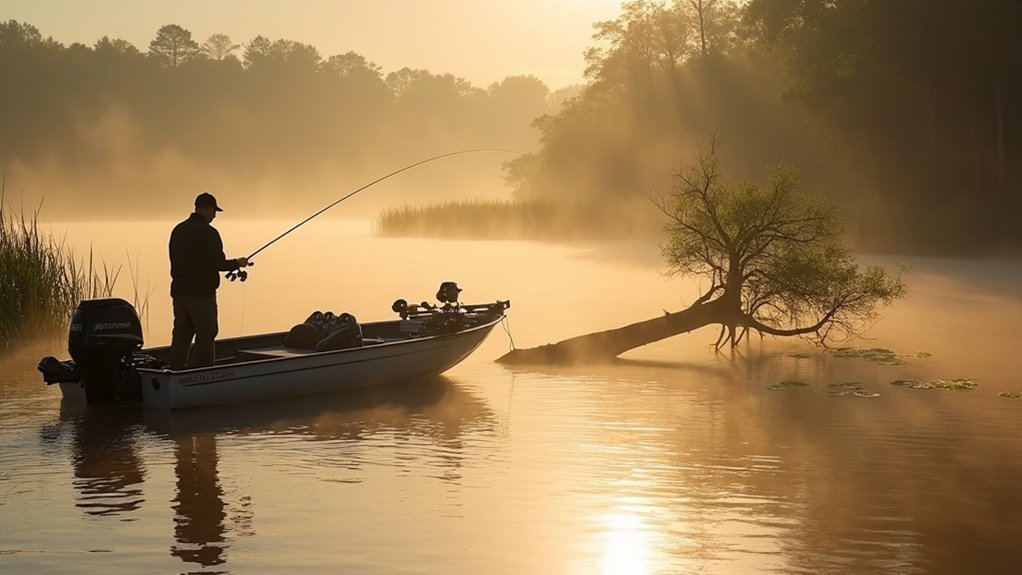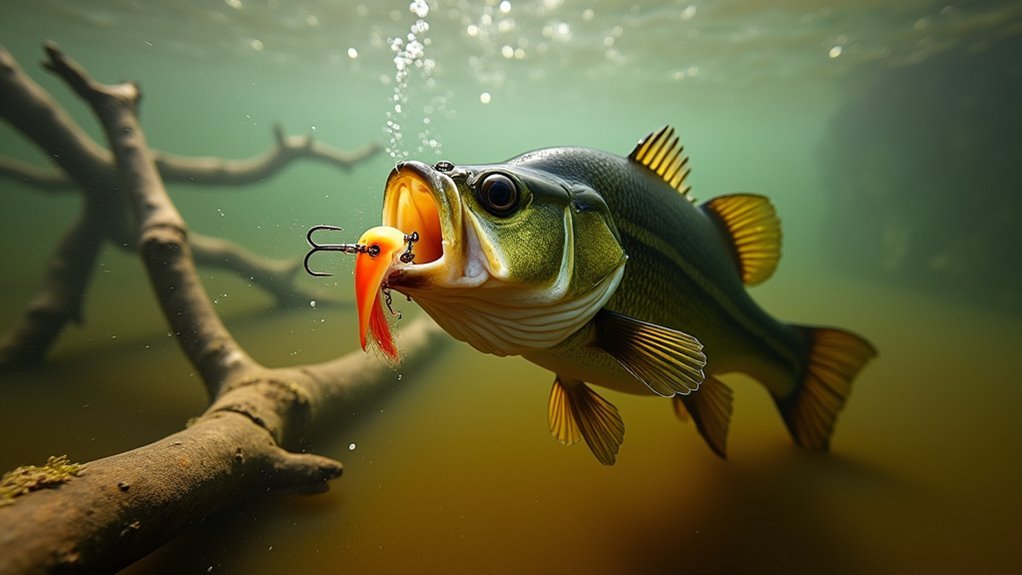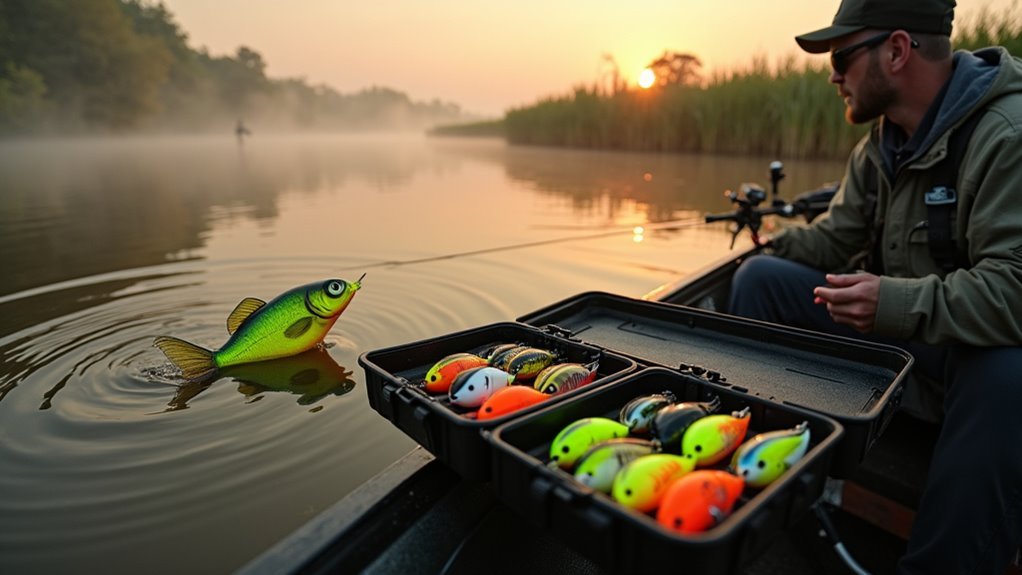To master bass fishing in murky waters, we need to adjust our approach. Bass move more cautiously in low visibility, so we’ll slow our retrieve and use brighter lures like chartreuse spinnerbaits or dark silhouettes that stand out. Adding scents like anise or garlic helps bass find our bait. We should target pronounced structures—stumps, docks, and runoff areas where baitfish gather. Patience pays off in muddy conditions; let’s give those big ones time to commit before setting the hook.
Understanding Bass Behavior in Low-Visibility Conditions

When muddy water rolls into your favorite fishing spot, understanding how bass behave in these conditions becomes your secret weapon. We’ve noticed bass head for cover and prefer shallower waters when visibility drops. They’re like us in a foggy parking lot—moving slower and more cautiously.
Try slowing your retrieve speed and be patient. Last summer, I waited nearly five minutes between casts at Lake Powell before landing a chunky largemouth. Bass also love hanging around runoff areas where baitfish gather. These muddy buffet lines are prime territory for hungry bass looking for an easy meal.
Prime Locations to Target When Waters Turn Muddy

Finding the right spot becomes your next challenge once you’ve figured out how bass behave in chocolate-colored water. We’ve found shore casting often yields the best results, especially if you approach quietly. Last spring, I scared off a monster bass by stomping around like a bull moose!
Focus on substantial structures – stumps, logs, and large rocks where bass hide. These spots aren’t just cover; they’re bass buffet lines. Runoff areas are goldmines too, as they attract baitfish and hungry predators.
Boat docks and launch ramps also concentrate bass when visibility drops. They provide both shelter and feeding opportunities.
Lure Selection Strategies for Stained Water Success

Choosing the right lures for muddy water fishing can make the difference between a frustrating day and a livewell full of bass. We’ve learned through countless trips that when visibility drops, you need to help bass find your bait.
Success in muddy water fishing hinges on lure selection – the difference between empty hands and bass-filled livewells.
- Larger, louder baits with vibration (chatterbaits, spinnerbaits with Colorado blades)
- Bright colors like chartreuse or high-contrast black for silhouettes
- Scented lures, especially with anise or garlic
- Crankbaits that deflect off structure, creating noise and disturbance
We’ve found that slowing your retrieve often seals the deal. Bass need more time to locate your offering in the chocolate milk!
Color and Scent Tactics That Trigger More Strikes

Why do some anglers consistently land bass in muddy water while others go home empty-handed? The secret often lies in color and scent selection.
In murky conditions, we’ve found bright colors like chartreuse and yellow grab a bass’s attention, while dark colors create visible silhouettes. I once caught a six-pounder on a black-and-chartreuse spinnerbait when nobody else was getting bites.
Don’t overlook scent – it’s your underwater billboard. Bass rely on smell when they can’t see well. Anise and garlic-based scents have saved many of our fishing trips. Pre-scented soft plastics work wonders too when visibility drops.
Adapting Your Retrieve Speed for Muddy Water Action

When visibility drops in muddy water, how quickly you work your lure becomes just as critical as what you’re throwing. We’ve found that slowing down your retrieve gives bass more time to locate and strike your bait in low-visibility conditions.
- Start ultra-slow, almost painfully slow – I once caught a 6-pounder that followed my spinnerbait for nearly 10 seconds before striking
- Add occasional pauses to create reaction strikes
- Vary your speed throughout the retrieve to determine what triggers bites
- Experiment with stop-and-go retrieves that mimic injured prey
Structure Fishing Techniques When You Can’t See the Bottom
Although you can’t see what’s lurking beneath muddy water, bass haven’t gone anywhere—they’ve simply repositioned around key structures. We’ve learned to fish by feel when visibility is poor, using our rods as underwater eyes.
Focus on pronounced structures—bridge pilings, submerged trees, and rocky points. They’re like bass magnets in murky conditions. We’ll tap these structures with our lures, feeling for that distinctive “tick” when we make contact.
I once landed a six-pounder by methodically bumping a jig along a submerged log I couldn’t see but knew was there. Trust your electronics and memory of the lake’s layout—they’ll guide you when your eyes can’t. Additionally, understanding hydrodynamic forces can help you better anticipate how bass may react to your lures in these challenging conditions.
Frequently Asked Questions
Does Barometric Pressure Affect Bass Behavior in Muddy Water?
Yes, we’ve found barometric pressure still affects bass in muddy water. They’re often sluggish during high pressure and more active during falling pressure, though muddy conditions may somewhat buffer these effects.
How Long Do Bass Typically Stay in Muddy Conditions Before Relocating?
We’ve found that bass typically stay in muddy water for 3-7 days, depending on severity. They’ll remain until visibility improves, especially if food is plentiful or it’s spawning season. They don’t immediately relocate.
Can Electronics Like Fish Finders Be Effective in Extremely Muddy Water?
We’ve found that fish finders still work in muddy water, though with reduced effectiveness. They’ll detect larger structures and fish silhouettes rather than clear images. Sonar technology with side-imaging often performs better than traditional sonar.
What Time of Day Offers the Best Muddy Water Fishing Opportunities?
We’ve found early morning and late evening offer the best muddy water bass fishing. During these low-light periods, bass are more active near shorelines and structure. We’ve noticed they’re less skittish and more willing to strike.
Should Hook Size Be Adjusted When Targeting Bass in Muddy Water?
We’ve found that 70% of successful muddy water bass strikes come from larger hooks. Yes, we’ll want to upsize our hooks slightly to accommodate bigger baits that create more vibration and presence in low-visibility conditions.
Conclusion
While most anglers flee muddy waters, we’ve learned that’s precisely when the biggest bass often bite. Ironically, the conditions that drive others away create perfect opportunities for those who understand how to adapt. We’ve caught our personal best bass in water so brown you couldn’t see your hand six inches deep! So next time rain muddies your favorite spot, don’t head home—change your approach and you might just land the trophy others missed.